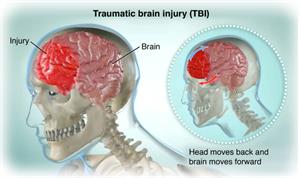Rehabilitation After Traumatic Brain Injury
What is rehabilitation after traumatic brain injury?
Traumatic brain injury (TBI) occurs when a sudden injury causes damage to your brain. A "closed head injury" may cause brain damage if something hits your head hard but doesn’t break through your skull. A "penetrating head injury" occurs when an object breaks through your skull and enters your brain.

Symptoms that may occur after TBI may include:
According to the CDC, the leading cause of TBI is falls, particularly for young children and adults age 65 and older. Other common causes of TBI include accidental blunt force trauma, motor vehicle accidents, and violent assaults.
If you have had a TBI, rehabilitation (or rehab) will be an important part of your recovery. Rehab can take many forms depending on your needs. It might include physical, occupational, and speech therapy, as well as psychiatric care and social support. All these are designed to help you recover from the effects of your injury as much as possible.
Why might I need rehab after traumatic brain injury?
Rehab may help:
-
Improve your ability to function at home and in your community
-
Help treat the mental and physical problems caused by TBI
-
Provide social and emotional support
-
Help you adapt to changes as they occur during your recovery
Rehab can also help prevent complications of TBI, such as:
-
Blood clots
-
Pain
-
Pressure ulcers, also called bedsores
-
Breathing problems and pneumonia
-
A drop in blood pressure when you move around
-
Muscle weakness and muscle spasm
-
Bowel and bladder problems
-
Reproductive and sexual function problems
What are the risks of rehab after traumatic brain injury?
Rehab after a TBI is not likely to cause problems. But there is always a risk that parts of treatment, such as physical or occupational therapy, might lead to new injuries or make existing symptoms or injuries worse if not done correctly.
That’s why it is important to work closely with your rehab specialist who will take steps to help prevent problems. But they may still happen. Be sure to discuss any concerns with your healthcare provider before rehab.
How do I get ready for rehab after traumatic brain injury?
Before you can start rehab, you must get care and treatment for the early effects of TBI. This might include:
-
Emergency treatment for head and any other injuries
-
Intensive care treatment
-
Surgery to repair brain or skull injuries
-
Recovery in the hospital
-
Transfer to a rehabilitation hospital
What happens during rehab after traumatic brain injury?
Every person's needs and abilities after TBI are different. You will have a rehab program designed especially for you. Your program is likely to involve many types of healthcare providers. It’s important to have a central person you can talk to. This person is often called your case coordinator or case manager. This person will help coordinate your care and work with you and your family on the type of available rehab programs and the rehab coverage offered by your health insurance company.
Over time, your program will likely change as your needs and abilities change.
Rehab can take place in various settings. You, your case coordinator, and your family should pick the setting that works best for you. Sometimes rehab choices are limited by the type of health insurance you have. Possible settings include:
-
Inpatient rehab hospital
-
Outpatient rehab hospital
-
Home-based rehab
-
A comprehensive day program
-
An independent living center
Your individual program may include any or all of these treatments:
You have many choices for rehab therapy, and the type of rehab therapy that you need will be determined by your care team. Your care team will assess your needs and abilities. This assessment may include:
-
Bowel and bladder control
-
Speech ability
-
Swallowing ability
-
Strength and coordination
-
Ability to understand language
-
Mental and behavioral state
-
Social support needs
What happens after rehab for traumatic brain injury?
How long your rehab lasts and how much follow-up care you will need afterwards depends on how severe your brain damage was and how well you respond to therapy. Some people may be able to return to the same level of ability they had before TBI. Others need lifetime care. Some people are helped by vocational rehab. This helps them learn new skills with the goal of employment.
Some long-term effects of TBI can show up years later. You may be at higher risk long-term for problems, such as Parkinson disease, Alzheimer disease, and other forms of dementia.
After rehab you may be given these directions:
-
Symptoms and signs that you should call your healthcare provider about
-
Symptoms and signs that are to be expected
-
Advice on safety and self-care
-
Advice on alcohol and illegal drug use
-
Community support resources available to you
Your primary care provider should be given all the records and recommendations from your therapy team to help make sure that you continue to get the right care.
Next steps
Before you agree to a test or procedure, make sure you know:
-
The name of the test or procedure
-
The reason you are having the test or procedure
-
What results to expect and what they mean
-
The risks and benefits of the test or procedure
-
What the possible side effects or complications are
-
When and where you are to have the test or procedure
-
Who will do the test or procedure and what that person’s qualifications are
-
What would happen if you did not have the test or procedure
-
Any alternative tests or procedures to think about
-
When and how you will get the results
-
Who to call after the test or procedure if you have questions or problems
-
How much you will have to pay for the test or procedure